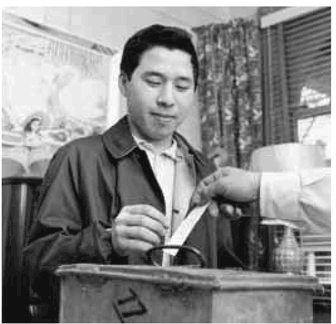Electoral Insight – New Ways of Building Democracy
Electoral Insight – November 1999
Electoral Facts
Wayne Brown, Elections Canada
 As this century ends, almost all adult Canadians have the right to vote. Since Confederation, the federal franchise has expanded greatly.
As this century ends, almost all adult Canadians have the right to vote. Since Confederation, the federal franchise has expanded greatly.
1867 Only a small minority of the population had the right to vote. At the first general election after Confederation, only men 21 years of age and over who met certain property qualifications could vote and be candidates in a federal election. All women, Status Indians and members of some religious denominations were excluded. Canada consisted of only four provinces (Ontario, Quebec, Nova Scotia and New Brunswick), represented by 181 members of Parliament. The right to vote was not laid down in federal law. In Canada's early decades, the franchise laws of each province applied to federal elections in that province. In certain provinces, this denied the franchise to particular groups, such as immigrants from Japan, China and India.
1885 Parliament established a federal franchise based on property ownership. Its application differed from town to town and from province to province. Aboriginal people living in certain parts of Canada had the right to vote.
1917 Parliament passed the Wartime Elections Act and the Military Voters Act. During a time when conscription was a major issue, the right to vote was extended to all British subjects, male or female, who were active or retired members of the armed forces, including Indian persons and persons under 21 years of age. Civilian men who were not landowners, but who had a son or grandson in the armed forces, were also temporarily granted the franchise, as were women with a father, mother, husband, son, daughter, brother or sister then serving, or who had previously served in the Canadian forces. At the December election, about 2 000 military nurses became the first Canadian women to vote at the federal level.
1918 Royal assent was given to a bill that extended to all Canadian women at least 21 years of age the right to vote in federal elections, provided they were not alien-born and met property requirements in the provinces that had such rules. (The next year, women also became eligible for election to the House of Commons.)
1920 Federal electoral law was amended to provide universal female (and male) suffrage regardless of provincial law. British subjects by birth or naturalization were qualified to vote, but certain foreign-born citizens continued to be excluded until 1922. At the 1921 election, for the first time, the number of electors on the lists exceeded 50 percent of the total population.
1948 The last vestiges of the property qualification, still in use in Quebec, were abolished. The right to vote was extended to Canadians of Asian origin.
1950 A clause dating back to 1934 disqualifying Eskimos (Inuit) from voting was abolished.

Voter casting his ballot during the 1963 federal election.
1960 Passage of a new Canada Elections Act removed the disqualification from voting for registered Indians living on reserves. This was partly the result of recognition that many Aboriginal people had served with distinction in the Canadian Forces during the Second World War.
1970 A revised Canada Elections Act lowered the voting age and the age of candidacy from 21 years to 18. The right to vote was restricted to Canadian citizens, although British subjects eligible to vote as of June 25, 1968, kept their right to vote until 1975. The new Act also introduced a system of proxy voting for fishermen, seamen, prospectors and full-time students absent from their electoral district. The right to vote in advance was extended to persons with disabilities.
1982 The new Canadian Charter of Rights and Freedoms entrenched in the Constitution the right of all citizens to vote in an election of members of the House of Commons or of a legislative assembly and to be candidates. The Canada Elections Act specifies that every person who has attained the age of 18 by polling day is qualified as an elector.
1988 Two separate court rulings gave the right to vote to about 500 federally appointed judges and persons with mental disabilities.
1993 Parliament passed legislation allowing Canadians to vote by special ballot if they cannot go to their regular or advance poll. This enables students away from their home district, travelling vacationers and business people, and those temporarily outside the country to use their right to vote.
1999 Almost all Canadian citizens 18 years of age and older are qualified to vote. Among the exceptions are impartial officials responsible for running elections: the Chief Electoral Officer, Assistant Chief Electoral Officer, and the returning officers (except when the latter are required to vote to break a tie on a recount). As well, on October 21, 1999, the Federal Court of Appeal ruled that inmates serving a sentence of two years or more may no longer vote in federal elections. Almost 20 million Canadians had the right to vote at the most recent federal general election in 1997. Almost all of the remainder of Canada's population were either under the age of 18 or were not Canadian citizens.
Note:
The opinions expressed are those of the authors; they do not necessarily reflect those of the Chief Electoral Officer of Canada.
